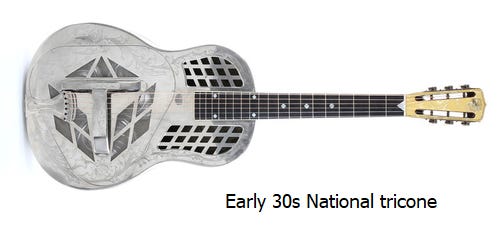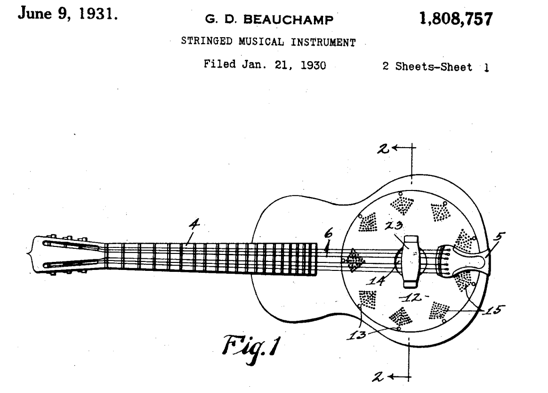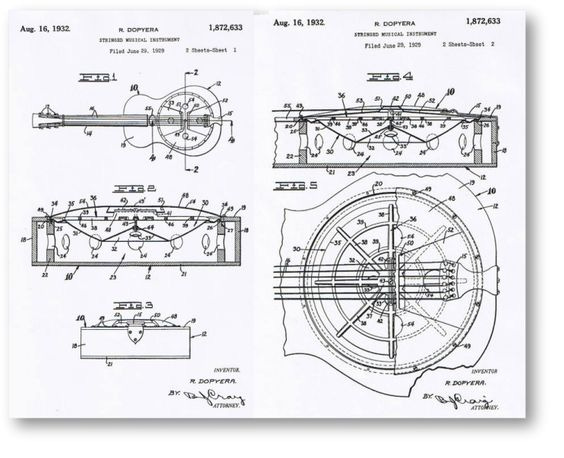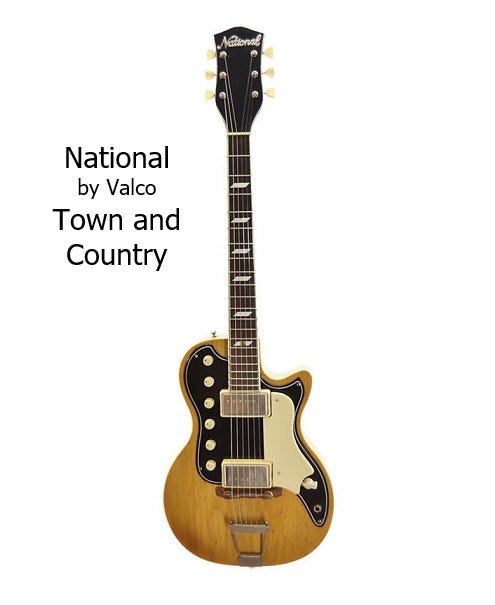Valco’s company history is focused on one of the partners, Louis Dopyera, who was the guy with all the guitar connections. He and his four brothers started the Dobro Manufacturing Company around 1932 and eventually absorbed the National String Instrument Corporation in 1934.
The resulting marriage was National Dobro, and the name “Dobro” comes from the “Do”pyera “Bro”thers.
The story is really much more complicated, and another brother, John Dopyera, is the star of that show from 1927 through the late 1930s.
John founded the National String Instrument Company (NSIC) with George Beauchamp. The George Beauchamp who invented the “frying pan” guitar as part of the eventual Rickenbacker fame.
However, before the frying pan, Beauchamp and John Dopyera developed the first resonator guitar based on a tri-cone system. Really it was Dopyera who invented and patented the guitar and Beauchamp was the GM/sales guy.
To raise capital, NSIC took on investors in 1928 and it didn’t end well. John and Beauchamp had disputes over developing a more affordable single-cone resonator and one of the investors was squeezing them for his ROI.
John quit National in 1929, leaving his patents behind and a few years later he formed the Dobro Manufacturing Company with his brothers.
One of those left behind patents was for a single-cone resonator that he and Beauchamp argued about and NSIC went on to produce (and patent).
The Dopyera brothers created their own single-cone and called their version a “Dobro”. A legal battle ensued between the two parties with the Dopyera’s coming out on top.
Now back to Louis Dopyera.
After the court settlement Louis bought a controlling interest in NSIC in which he promptly fired Beauchamp, go figure. NSIC and Dobro operated as separate entities until the two companies merged as National Dobro Corporation in 1934.
Rabbit Hole
It’s worth pointing out that Gibson owns the trademarked name “Dobro” and acquired the rights in 1993. If you have a dobro, you actually have a resonator guitar. It’s like referring to a tissue you use to blow your nose as “Kleenex”. Other examples are Band-Aid, Scotch Tape and Velcro.
In 1936 the company headquarters relocated from California to Chicago to be closer to the epicenter of instrument manufacturing. With strained finances due to the Great Depression and fallout from the legal battle the business model was soon to be re-tooled, focusing more on electric guitars.
Louis took on a couple of business partners and the resulting company name was Valco (a combination of the three business partners first initials followed by the abbreviation “co” from company). Valco absorbed National Dobro.
Then came WWII. Essential manufacturing only.
After surviving WWII by producing airplane parts the group was able to return to making instruments (and amplifiers).
During the 1950s and 60s Valco produced all kinds of guitar centric products including pickups and amps mostly for other brands. Its two house guitar brands were National and Supro, but also provided instruments for Silvertone, Academy, and Oahu. Amps were built for Gretsch and JC Penny. Valco was bought by Kay in 1967 and Kay went out of business a year later.
Their first high-end offering was the 1955 National Town and Country.
Specs: Maple body, Valco pickups, Three way rotary dial, Two volume and two tone controls for the pickups, One master volume and tone control for the pickup combo, Rosewood bridge






2 comments
The settlement and merger of the two companies is much more involved than stated above…
Actually, Valco bought Kay from the Seeburg company, famous for juke boxes, who had purchased Kay in 1965.